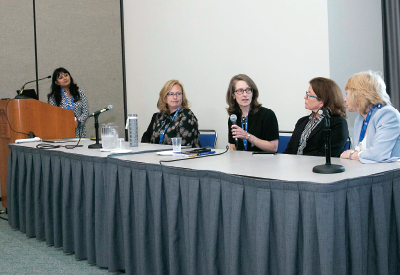Panel Discusses the Obstacles Facing Women in Medicine
Abstract
On average the annual income difference between men and women psychiatrists of comparable age, rank, and productivity is $15,000, according to a study in JAMA Internal Medicine.
Cheryl McCullumsmith, M.D., Ph.D., an associate professor of psychiatry at the University of Cincinnati, was helping to plan a session for the annual meeting of the National Network of Depression Centers (NNDC) when the group she was working with realized that all the scheduled panelists were men.

From left: Science writer Apoorva Mandavilli (moderator) and panelists Karen Cropsey, Psy.D., Erika Saunders, M.D., Jennifer Wagman, Ph.D., and Gail Robinson, M.D., described lessons learned from their professional experiences to help women in academic psychiatry advance in their careers.
After a short pause, one of the other planning committee members said to McCullumsmith, “Cheryl, you’re a female. You should speak at the meeting.”
While the scenario may sound like that of a bygone era, this was prior to NNDC’s 2016 annual meeting.
McCullumsmith’s experience is far from rare in medicine, where women still lag behind men in representation at major meetings or in high-ranking academic or clinical positions. Studies, including a 2016 report in JAMA Internal Medicine, found that even women who achieve great academic success tend to encounter biases such as lower pay.
What does this mean for the field of psychiatry? At APA’s 2017 Annual Meeting, McCullumsmith joined with other women colleagues to share their experiences and strategies for overcoming gender disparities in medicine in the session “Sticky Floor or Glass Ceiling? An Open Panel Discussion About Keeping and Advancing Women in Academic Psychiatry.”
Jennifer Wagman, Ph.D., an assistant professor of global public health at the University of California, San Diego, described data from a 2012 survey of women in academic medicine that compared their advancement relative to men.
The data indicated that as early as at the assistant professor level, women in medicine are outnumbered by men; and these numbers only worsen as they move up the academic ranks—from associate professors to full professors to department chairs. Women also report lower income and less career satisfaction.
Interestingly, the same surveys found that women researchers had similar numbers of funded grants as men, yet reported fewer publications on average.
“More research is needed to understand why equal grant productivity does not translate to equivalent publications,” Wagman said. “However, the observed differences look to be attributed to a loss of female faculty over time due in part to inequitable salaries and inadequate support for family leave. It shows that policies of protection and correction are needed.”
What policies might be helpful? Erika Saunders, M.D., chair of psychiatry at Penn State University, suggested that part-time medical training might be one way to make work-life balance for new mothers more manageable.
“Part-time training does bring both advantages and disadvantages,” Saunders said. She described feedback from psychiatry residents who had done part-time training at the University of Michigan. Some residents liked that they were not being left behind; others expressed feeling less connected to their fellow residents. “But the majority said it was positive for their success and their professional development.”
Other policies that promote career flexibility, including family-friendly leave of absence policies or paid paternal leave may also help to promote the advancement of women clinicians.
Even women who move up the academic ladder can face significant obstacles, noted Karen Cropsey, Psy.D., an associate professor at the University of Alabama School of Public Health. For example, women are more likely than men to be put in perilous leadership positions. She cautioned that while research has shown that the “glass cliff” exists, it remains unclear why. It could be a case of setting up women for failure or it might be a positive bias that women can handle stress better and manage successfully in times of crisis, she said.
Gail Robinson, M.D., a professor of psychiatry and obstetrics/gynecology at the University of Toronto, rounded out the panel session with some helpful advice to help crack that academic glass ceiling, or as she phrased it, “that dense layer of men.”
“Women tend to be more reserved, but success requires self-promotion, and that involves communication and visibility,” she said.
While Robinson noted that it is important to be respectful, it is important to do so in a way that is not perceived as subordinate. Avoid framing responses with phrases like “I hope” or “I feel” or overapologizing for perceived slights, she suggested.
“Your main goal is promoting yourself,” she concluded. “Yes, you have to make contributions. But don’t assume they will become known and you will be rewarded. Take credit for your accomplishments.” ■



